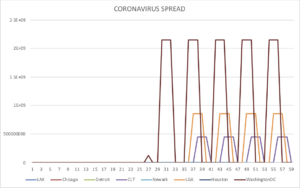Steps for industry and government to prepare for the Coronavirus

As I noted in an earlier blog, the issue of global epidemics is something that we have seen in the past with the SARS epidemic. People sometimes think these come around once every ten years – but the reality is, that in a world where global travel and open borders is common, a small virus can quickly grow if left unfettered. Now that the epidemic is here in the U.S., we are likely to see the spread of this much more quickly.
When I was working on this study back in 2010, I had a graduate student look at the number of flights between major airports in the U.S., and estimate what the rate of spread of the virus might look like, using a rough Monte Carlo simulation model. The graph below gives an idea of how quickly this spread might occur. (Note: it is NOT meant to be predictive, but is very much limited by the assumptions one makes and is thus not a scientific estimate of any sort!) So what can be done if the CoVid does spread further? Here are some of the insights from our last report that we developed.

Governments must work closely with private industry, and cannot be relied on to be the sole responders to pandemic influenza. Guidelines should be developed in conjunction with industry groups, to better understand current practices, implement improvements in pandemic planning, and identify mechanisms for coordination and key trigger points that can generate alternative actions.
The primary mechanism for government-private industry coordination should occur at an industry forum level. There is a need for private enterprises to work together with key suppliers and customers in industry forums that bring together sharing of best practices, port-mortem lessons learned, and specific ideas and initiatives to improve preparedness. Government sponsorship of these forums is an important part of the communication action plan.
Governance is a critical foundation for pandemic planning. Every major public and private institution should be required to implement some form of pandemic planning committee and risk mitigation plan. These committees should follow clear guidelines and implement action plans that would be put into effect upon announcement of pandemic trigger points.
Coordination between federal and state distribution of national stockpiles needs to be improved. Our research suggest that state-level distribution centers with pre-positioned stockpiles could provide improved response and deployment of anti-virals, masks, gloves, and vaccines. Improvements in vaccine technologies should be encouraged in all cases, to improve response time.
Information systems support systems and training of key individuals in conjunction with risk planning is an important component to pandemic plans. Our research indicates that current systems that are in place could fail if large portions of the economy move to teleworking, and there are not firm plans in place to identify critical workers.
Supply chain mapping and risk analyses are required to identify potential failure points that could impact the economy. Examples include coal supporting energy grids, information systems and hardware support, critical hospital personnel and supplies, and first responders may be in short supply in the event of a severe pandemic.
Small businesses are likely to be the hardest hit by a pandemic, and could result in major economic failure of this sector. Small businesses are least prepared for a pandemic, and in the current economic climate, can least afford worker attrition due to illness.
Joint exercises in collaboration with industry and small business sectors should be taken to provide simulated conditions for a pandemic, with lessons learned and gaps identified for risk mitigation and planning.
Food chains should be required to identify appropriate warning triggers and stockpiles, along with distribution plans to ensure adequate supplies of food during a pandemic. Current systems may not have enough warning to enable pre-positioning of supplies without adequate lead-time.
These recommendations reflect our current thinking. Clearly, there is a need for significant research in this realm to better understand the gaps and limitations of different industries. Our research suggests that there is especially a need for research in the requirements for supply chain planning, strategic stockpiles of hospital and medical supplies, food distribution planning, and risk maps identifying sectors that are most exposed. There is also a need for industry joint exercises and training, so that collaboration between public and private entities can be forged, with specific actions and requirements for joint activity and triggers specified and agreed on both horizontally and vertically in key supply chains.
In the meantime, keep your hands clean and don’t touch your face!


